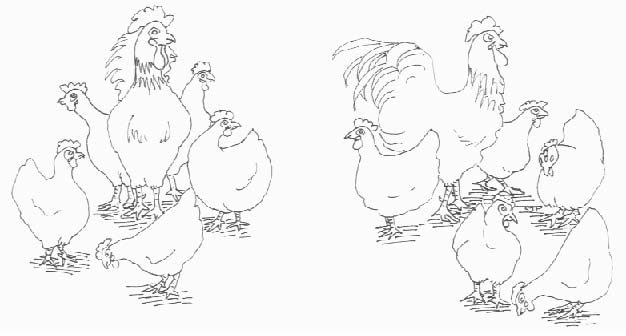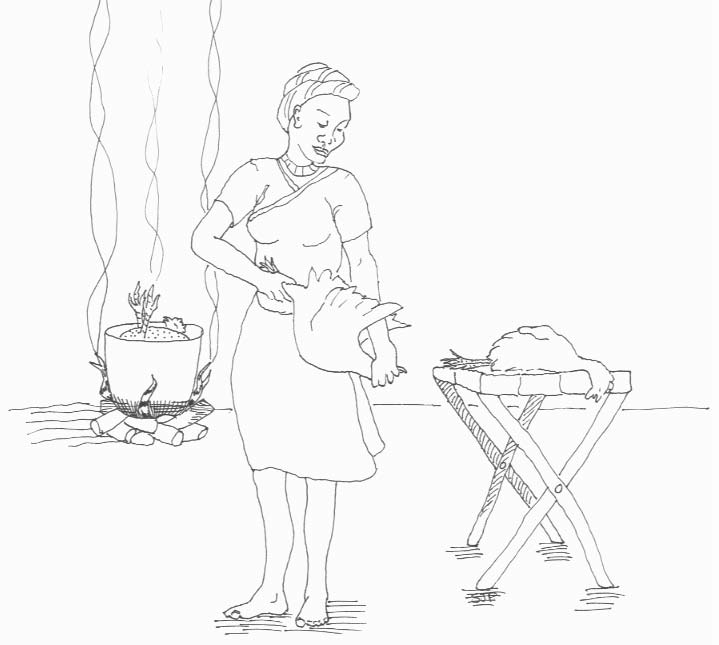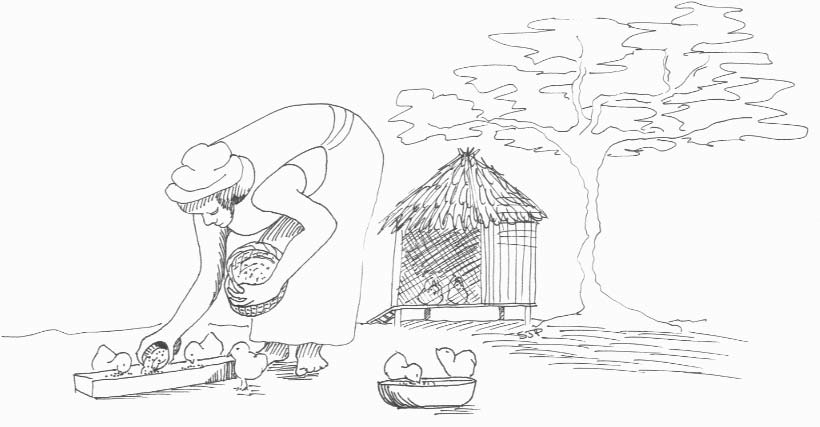A Simple Guide to Managing Village Poultry in South Africa – English version
A Simple Guide to Managing Village Poultry in South Africa

Illustration: Susan Powell
The main aim of this guide is to help rural families (village people) who have only a few chickens and who are unable to get advice easily to increase production of meat and eggs from their chickens. Their meat and eggs provide protein essential for children to grow and to allow their brain to develop well so that they can learn more easily and become tall and strong. It is also important that mothers who are nursing their babies have enough of the high-quality protein that eggs and chicken meat contain. Good nutrition is essential for good health.
This book is designed to increase the productivity of indigenous (local) chickens who are scavenging (finding their own food) and mostly caring for themselves, by introducing basic, simple approaches and very small inputs that will not be costly. Often women care for chickens because they recognise how important eggs and chicken meat are for good nutrition and health, for themselves and their children. Chicken rearing can also provide additional money. Local chickens and old hens often fetch a good price in South Africa and eggs are easily sold to neighbours.

Illustration: Susan Powell
Housing
- Chickens need a good strong house. Chickens should be locked up at night to protect them from bad weather, predators, and thieves. A house will also allow you to inspect the birds and to handle them to see if any are sick or need attention. It allows you to collect their eggs from the same place.
- Plan very carefully where you build the chicken house. You will need a shady, dry, safe place on flat ground to keep the floor dry during the rainy season. It may be necessary to dig a drain around the house, or to raise the ground first.
- The house can be made cheaply using local material like gumpoles, reeds and thatch grass. You must see what is available. It should be situated close to your own house with the grass and bush cleared for about 3 paces (metres) on all sides of the house to keep snakes and rats away from your chickens. Some houses are built on poles, well above the ground. This protects chickens from predators (thieves) like dogs, rats, snakes and humans.
- The size of the house will depend on how many birds you have. For 10 – 15 adult birds, the size of the house should be about 2 large paces (metres) wide by 2 large paces (metres) long. It is better that the house is too big than too small.
- The house should have a secure door; it should allow plenty of light and air movement. It should keep the chickens dry and protected from the wind. There should be perches, as hens like to sleep above (off) the floor of the house.

Illustration: Susan Powell
- In the house put a feeder and a water container. This can be made cheaply from a tin can or a clay jar upturned in a shallow container. Move the drinker frequently to different places in the shed as the ground gets wet around the drinker.
- The chicken home should be kept clean by raking the dirt floor inside the house often. You can put litter (bedding) like wood shavings or finely chopped grass on the floor if you have some available. Manure and litter should be removed at least once a month and left to rot before putting it on your vegetable garden. Your vegetables will then grow much better.

Illustration: Susan Powell
Breeding and Hatching
- You must watch which hens produce many eggs; how well do they sit on their eggs; how well do they raise their chicks, so that you can choose those hens that make the best mothers. Keep the pullets (new young hens) for your flock from those mothers with these characteristics.
- Keep those hens that produce strong chicks that are fast-growing for meat and those that grow to a large size. The large, fast-growing chicks are usually the male birds (cockerels) and are best to eat.
- Hens should be mated to these large cockerels. You will need 2 cockerels for 10 pullets. Sell or eat the male chickens that do not grow well. Do not keep them for breeding.
- It is a good idea from time to time to swap one or two cockerels and a few hens with your distant neighbours, to reduce inbreeding. That is to stop fathers and daughters, and mothers and sons from mating with one another. This inbreeding causes poor growth and fewer eggs from their chicks.
- Get rid of any birds that are not laying well (See Section III later). They are eating your food and producing nothing.
-

Illustration: Susan Powell Provide a separate nest well off the ground for the broody hens who want to hatch their eggs in the hen house. This could be a woven basket. Put in a layer of dried grass, then some sand and finally a layer of straw or thatch grass. The eggs will not then break easily and many chicks should hatch out.
- The nest should be placed in a dark, quiet corner and away from roosting (sleeping) birds in the hen house. Water and feed should be given regularly to the broody hen who is sitting on the eggs. Chicks will hatch out after 21 days. Remove all eggs that are laid each day. When a good hen goes broody put no more than 6 to 8 fresh eggs under her to hatch. Hens can only raise a very few chicks successfully. The eggs should be from those hens that produce many eggs, or whose chicks grow quickly into heavy meat birds (see points 1 & 2 above).
- Not every hen that goes broody should be given eggs to sit on but only the good mothers. If you put a broody hen by herself in a cage hung up in the shade for 4 – 5 days with food and water, she will stop being broody and will start to lay more eggs.

Illustration: Susan Powell
Rearing Chickens
- Newly hatched chicks need special care. Some hens are better mothers than others and successfully rear many strong and healthy chicks.
- The first 3 – 4 weeks of life are very important and the chicks need a lot of protection from predators and the weather. They should be put into an enclosed pen to protect them. The pen must be movable and large enough for the chicks to scavenge with their mother. The pen should be moved to fresh ground each day and make sure that there is some extra kitchen waste for them.
- The chicks must be kept dry and warm. It is important that they learn with their mothers how to scavenge (search) for food. At night the mother and chicks should be shut up in the hen house which is very secure.
- During the day the chicks should be given additional feed. To start with, this could be a hard-boiled egg that is chopped into pieces, then small amounts of finely crushed grain, bread, cooked or raw mealie meal. After 10 days feed chicks only twice a day and give them only what they can clean up quickly, otherwise feed will be wasted.
- The mother must not eat the chicks’ feed. A small enclosure where the food is placed should be made so that the chicks can enter but not the mother.
- Clean, freshwater should also be provided in a suitable container but chicks should not be allowed to get wet. You can put clean stones in the drinker to stop the chicks from falling into the drinking water.
- Remove any dead chicks immediately and bury them far away from the pen and chicken house.
- When chicks are 3 – 4 weeks old, they can leave their movable pen to scavenge more widely for their food with their mother. They still need some additional feed separately from the rest of the flock and from their mother if they are to grow well and keep healthy.
- By about 4 weeks of age, you will be able to separate the males from the females by looking at them. Males will grow faster and they should be given extra feed to allow them to do this. Try to feed them separately from the rest of the flock for about half an hour each day.
- Do not wait until the males are fully-grown before you eat them or sell them. This means that you will save feed and have more room in your hen house for new chickens to replace them. You will have more feed left to give to other chickens.

Illustration: Susan Powell
Management of Hens
- Chickens will start to lay when they are 6 – 8 months old. Good feeding and care will result in the birds coming into lay early and producing many more eggs.
- Hens in lay will have a large red shiny comb. A hen not in lay will have a shrivelled, pale comb. Hens normally go in and out of lay so their combs will change colour from time to time.
- Collect all eggs from the nest boxes at least once each day. As stated previously, only put a few (6 – 8) eggs under the broody hen that you have selected.
- Do not store eggs in a warm place. Do not keep them for more than 5 – 7 days before selling or eating them as the eggs will go stale and many will not hatch out when put under the broody hen.
- Select clean, large eggs with good shells for putting under a broody hen. Eggs with thin or cracked shells will not hatch. A large egg will produce a big chick which will be healthy and has a good chance of growing into an adult bird.
- When hens are about 2 – 3 years old they will either stop laying or lay only a few eggs. They are eating your valuable feed and returning nothing to you. You must eat or sell them and replace them with young hens that are coming into lay.

Illustration: Susan Powell
Feeding
Chickens need a good mixture of feeds from many sources to grow well and to produce many eggs. They also need a clean water supply.
- They will find some of their feed by scratching the ground for snails, insects, grains, worms, seeds and grass and other plants. This is a good mixture but usually not enough for them to produce well. They need extra feed.
- If you can afford to buy a little feed you should do so for the very young chicks. They will eat only small amounts of chick starter feed or ground grain to 4 – 5 weeks of age. These can be bought from the feed store. Do not let older birds eat this feed, it is too expensive and valuable for them. If the feed comes in a bag that is too large for your needs or therefore too costly, you could share the feed and purchase cost with your neighbours.
- Do not fill the feed trough more than half full with dry feed otherwise, chicks will spill and waste it.
- Hens do not often have enough calcium to make the shells for their eggs that will not break easily. Snails are a good source of calcium but limestone is very cheap and should be given in a separate container placed in a dry place. Crushed eggshells can be given to the hens to supply calcium, but boil them first with the raw vegetables. Shells will not then spread disease.
Household food waste is important. This should be saved and given to your chickens fresh each day in a feeder. If you have spare fresh garden vegetables such as potatoes, carrots, cabbage leaves and the like, it is better to cook them first as the hens find it easier to digest them when cooked. Ripe bananas and other fruits are good for poultry. It is a good idea to give birds the household scraps when you close the door of their house at night. This will encourage them to look for food when they get out in the morning.

- Bones from cooked chickens and other animals can be sun-dried, then crushed finely with a stone and fed back to your poultry. These contain important minerals, including calcium, for your birds to grow and remain healthy.
- Maize bran and wheat bran are sometimes available. These are good for adult chickens. You must always be looking for additional feed for your chickens. They never have sufficient feed.
Health

- Cleanliness is the key to healthy chickens. Only healthy birds will lay many eggs and grow well.
- To keep birds healthy, you must provide them with clean water. Clean the water and feed troughs and clean the hen house often.
- Birds should be inspected daily to see if any are sick.
- Sick birds should be removed from the rest of the flock and housed separately and given fresh water and extra food. If they are small they should be kept warm and dry. If they do not recover in 4 – 5 days you must kill and bury them far away.
- A young sick bird will not eat. It will have puffed up feathers and may have wet and bloody droppings. Old, sick birds may have dirty feathers around the vent (backside). There may be sores on the comb and wattles. Some birds may not be able to walk well. Weak legs and curled toes may be the problem. If they cannot walk well you should kill them, as they will eventually die anyway.

Illustration: Susan Powell
- Any chicken that dies should be removed immediately and burnt or buried. Do not eat it because it may make your family ill.
- Your poultry must be kept healthy if they are to grow well and lay many eggs. Some diseases are in your village all the time and your birds must be protected by vaccination.
- Newcastle Disease can suddenly kill off all your birds and it is very important to vaccinate against this disease before they get sick. You will need to get information from the local poultry advisory officer about vaccinating the birds. If you don’t, you may suddenly lose your entire flock.
- In the case of several sick birds, you should seek advice immediately from someone who is an expert on poultry diseases. You may then have to try special medicine for your birds.

Illustration: Susan Powell
Acknowledgements
I wish to thank the following for translating the text into local languages: Kobie du Preez into Afrikaans; Tebo Magolego into Sotho; Joyce Mafu into Xhosa; Qeda Nyoka into Zulu and Edward Nesamvuni into Tshivenda.
Helpful comments on the text were made by Ed Wethli, Stephen Slippers and Edward Nesamvuni.
Illustrations were skilfully drawn by Susan Powell who also made useful comments. I thank Kathy Kamarinos for proficiently word processing and assembling the book.
Funding for the book was from an Australian-funded LINK Project managed by the International Development Program, Canberra and from a grant provided by the International Union of Nutritional Sciences. I am most grateful for these funds.
D.J. FARRELL
The University of Queensland
April, 2000

